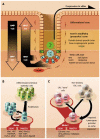Intestinal stem cells and the colorectal cancer microenvironment
- PMID: 24587669
- PMCID: PMC3934460
- DOI: 10.3748/wjg.v20.i8.1898
Intestinal stem cells and the colorectal cancer microenvironment
Abstract
Colorectal cancer (CRC) remains a highly fatal condition in part due to its resilience to treatment and its propensity to spread beyond the site of primary occurrence. One possible avenue for cancer to escape eradication is via stem-like cancer cells that, through phenotypic heterogeneity, are more resilient than other tumor constituents and are key contributors to cancer growth and metastasis. These proliferative tumor cells are theorized to possess many properties akin to normal intestinal stem cells. Not only do these CRC "stem" cells demonstrate similar restorative ability, they also share many cell pathways and surface markers in common, as well as respond to the same key niche stimuli. With the improvement of techniques for epithelial stem cell identification, our understanding of CRC behavior is also evolving. Emerging evidence about cellular plasticity and epithelial mesenchymal transition are shedding light onto metastatic CRC processes and are also challenging fundamental concepts about unidirectional epithelial proliferation. This review aims to reappraise evidence supporting the existence and behavior of CRC stem cells, their relationship to normal stem cells, and their possible dependence on the stem cell niche.
Keywords: Cell dedifferentiation; Colon cancer stem cells; DCLK1 protein; Stem cell niche.
Figures



Similar articles
-
Hallmarks in colorectal cancer: angiogenesis and cancer stem-like cells.World J Gastroenterol. 2014 Apr 21;20(15):4189-96. doi: 10.3748/wjg.v20.i15.4189. World J Gastroenterol. 2014. PMID: 24764657 Free PMC article. Review.
-
Cellular Interactions in the Intestinal Stem Cell Niche.Arch Immunol Ther Exp (Warsz). 2019 Feb;67(1):19-26. doi: 10.1007/s00005-018-0524-8. Epub 2018 Sep 21. Arch Immunol Ther Exp (Warsz). 2019. PMID: 30242440 Free PMC article. Review.
-
The SOX17/miR-371-5p/SOX2 axis inhibits EMT, stem cell properties and metastasis in colorectal cancer.Oncotarget. 2015 Apr 20;6(11):9099-112. doi: 10.18632/oncotarget.3603. Oncotarget. 2015. PMID: 25868860 Free PMC article.
-
Overexpression of snail induces epithelial-mesenchymal transition and a cancer stem cell-like phenotype in human colorectal cancer cells.Cancer Med. 2012 Aug;1(1):5-16. doi: 10.1002/cam4.4. Epub 2012 Jun 8. Cancer Med. 2012. PMID: 23342249 Free PMC article.
-
Incomplete cellular reprogramming of colorectal cancer cells elicits an epithelial/mesenchymal hybrid phenotype.J Biomed Sci. 2018 Jul 19;25(1):57. doi: 10.1186/s12929-018-0461-1. J Biomed Sci. 2018. PMID: 30025541 Free PMC article.
Cited by
-
Characterisation of mesenchymal colon tumour-derived cells in tumourspheres as a model for colorectal cancer progression.Int J Oncol. 2018 Dec;53(6):2379-2396. doi: 10.3892/ijo.2018.4565. Epub 2018 Sep 18. Int J Oncol. 2018. PMID: 30272331 Free PMC article.
-
Lithium chloride increases sensitivity to photon irradiation treatment in primary mesenchymal colon cancer cells.Mol Med Rep. 2020 Mar;21(3):1501-1508. doi: 10.3892/mmr.2020.10956. Epub 2020 Jan 21. Mol Med Rep. 2020. PMID: 32016459 Free PMC article.
-
The Epithelial to Mesenchymal Transition in Colorectal Cancer Progression: The Emerging Role of Succinate Dehydrogenase Alterations and Succinate Accumulation.Biomedicines. 2023 May 11;11(5):1428. doi: 10.3390/biomedicines11051428. Biomedicines. 2023. PMID: 37239099 Free PMC article. Review.
-
Tuft and Cancer Stem Cell Marker DCLK1: A New Target to Enhance Anti-Tumor Immunity in the Tumor Microenvironment.Cancers (Basel). 2020 Dec 17;12(12):3801. doi: 10.3390/cancers12123801. Cancers (Basel). 2020. PMID: 33348546 Free PMC article. Review.
-
From Crypts to Cancer: A Holistic Perspective on Colorectal Carcinogenesis and Therapeutic Strategies.Int J Mol Sci. 2024 Aug 30;25(17):9463. doi: 10.3390/ijms25179463. Int J Mol Sci. 2024. PMID: 39273409 Free PMC article. Review.
References
-
- Siegel R, Naishadham D, Jemal A. Cancer statistics, 2012. CA Cancer J Clin. 2012;62:10–29. - PubMed
-
- Population Reference Bureau. 2012 World Population Sheet. Available from: http://www.prb.org/pdf12/2012-population-data-sheet_eng.pdf.
-
- Cancer research UK. Colorectal Cancer. 2011. Available from: http://www.cancerresearchuk.org/cancer-info/cancerstats/world/colorectal....
-
- Ferlay J, Steliarova-Foucher E, Lortet-Tieulent J, Rosso S, Coebergh JW, Comber H, Forman D, Bray F. Cancer incidence and mortality patterns in Europe: estimates for 40 countries in 2012. Eur J Cancer. 2013;49:1374–1403. - PubMed
-
- Ferlay J, Shin HR, Bray F, Forman D, Mathers C, Parkin DM. GLOBOCAN v2.0, Cancer Incidence and Mortality Worldwide: IARC CancerBase No. 10 [Internet] Lyon: International Agency for Research on Cancer; 2010.
Publication types
MeSH terms
LinkOut - more resources
Full Text Sources
Other Literature Sources
Medical

